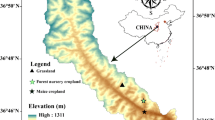Abstract
In a preliminary experiment we found that methane evolved from a sandy subsoil during aerobic incubation of shaken soil slurries. In the study presented here the methane was found to be released from the sand particles by mechanical weathering, caused by the grinding effect of the shaking. Large amounts of gas (about 0.5 ml gas g−1 soil) were extracted by intense grinding of the soil in gas tight serum vials. Methane was the main hydrocarbon in the emitted gas, but also a considerable amount of ethane was present, as well as minor amounts of heavier hydrocarbons (up to C6). The δ13C-values of the emitted methane and ethane were --33 ‰ and --29 ‰, respectively. Together these results demonstrate a thermogenic origin of the gas. This paper also reports the results of an incubation experiment where possible methane oxidation was looked for. If a possible release of methane is not accounted for, methane oxidation may be overlooked, as illustrated in this paper. Methane consumption was detected only in soil from 40 cm, in contrast to soil sampled at 100 cm and deeper where a slight production was measured. When methane oxidation was inhibited by dimethyl-ether, a significant release of methane was seen. The release was probably caused by chemical weathering. When this methane release was taken into account, methane oxidation was found to be present at all measured depths (40 to 200 cm). Fertilization with urea inhibited the methane oxidation at 40 cm but not at deeper layers. It is hypothesized that ammonia oxidizing bacteria were the main methane oxidizers in this mineral subsoil (deeper than 1 m), and that oxidation of methane might be a survival mechanism for ammonia oxidizers in ammonia limited environments.
Similar content being viewed by others
References
Andresen B & Throndsen T (1989) Isotopic analysis of hydrocarbon gases. Norwegian Petroleum Society Conference: Shallow Gas and Leaky Reservoirs, Stavanger, April 10–11
Bakken LR (1988) Denitrification under different cultivated plants: Effect of soil moisture tension, nitrate concentration and plant photosynthetic activity. Biol. Fert. Soils 6: 271-278
Bakken LR & Olsen OA (1983) Buoyant densities and dry-matter contents of microorganisms: Conversion of a measured biovolume into biomass. Appl. Env. Microbiol. 45: 1188-1195
Bédard C & Knowles R (1989) Physiology, biochemistry and specific inhibitors of CH4, NH +4 and CO oxidation by methanotrophs and nitrifiers. Microbiological Reviews 53: 68-84
Born M, Dörr H & Levin I (1990) Methane consumption in aerated soils of the temperate zone. Tellus 2-8
Brock TD, Madigan MT, Martinko JM & Parker J (1994) Biology of microorganisms (p 829, Ch. 20). Prentice Hall, New Jersey
Coleman DD, Risatti JB & Schoell M (1981) Fractionation of carbon and hydrogen isotopes by methane-oxidizing bacteria. Geochim. Cosmoch. Act. 45: 1033-1037
French HK, Swensen B, Englund JO Meyer KF & van der Zee SEATM (1994) A lysimeter trench for reactive pollutant transport studies In: Soveri J and Suokko T (Eds) Future Groundwater at Risk. International Association of Hydrological Sciences (IAHS) Publ. No. 222: 131-138
Fritz P & Fontes JCh (1980) Handbook of Environmental Isotope Geochemistry, Vol. 1. The Terrestrial Environment. Elsevier
Hansen S, Mæhlum JE & Bakken LR (1993) N2O and CH4 fluxes in soil influenced by fertilization and tractor traffic. Soil Biol. Biochem. 25: 621-630
Hyman MR & Wood PM (1983) Methane oxidation by Nitrosomonas eurpoaea. Biochem. J. 212: 31-37
Hyman MR & Wood PM (1984) Ethylene oxidation by Nitrosomonas europaea. Arch. Microbiol. 137: 155-158
Jiang QQ (1996) Nitrosospira from terrestrial environments, its urease activity and nitrous oxide production. Doctor Scientiarum theses, 1996: 21. Agricultural University of Norway.
Jones RJ & Morita RY (1983) Methane oxidation by Nitrosococcus oceanus and Nitrosomonas europaea. Appl. Environ. Microbiol. 45: 401-410
Larsen E (1994) Regulerende faktorer for oksidasjon av metan i organisk jord (Regulating factors of methane oxidation in organic soil). Master Thesis, Dept. of Chemistry, University of Oslo.
Levin I, Bergamaschi P, Dörr H & Trapp D (1993) Stable isotopic signature of methane from major sources in Germany. Chemosphere 26: 161-177
Lilley MD, Butterfield DA, Olson EJ, Lupton JE, Macko SA & McDuff RE (1993) Anomalous CH4 and NH +4 concentrations at an unsedimented mid-ocean-ridge hydrothermal system. Nature 364: 45-47
Schipper LA & Reddy KR (1996) Determination of methane oxidation in the rhizosphere of Sagittaria lancifolia using methyl fluoride. Soil. Sci. Soc. Am. J. 60: 611-616
Schoell M (1988) Multiple origins of methane in the earth. Chemical Geology 71: 1-10
Sitaula BK, Luo J & Bakken LR (1992) Rapid analysis of climate gases by wide bore capillary gas chromatography. J. Environ. Qual. 21: 493-496
Swensen B (1997) Unsaturated flow in a layered, glacial-contact delta deposit measured by the use of 18O, Cl− and Br− as tracers. Soil Sci. 162: 242-253
Swensen B & Bakken LR (1998) Urease activity and nitrification potential in a mineral subsoil. Soil Biol. Biochem. 30: 1333-1341
Swensen B & Singh BR (1997) Transport and transformation of urea and its derivatives through a mineral sub-soil. J. Environ. Qual. 26: 1516-1523
Teveldal S, Jørgensen, P & Stuanes AO (1990) Long-term weathering of silicates in a sandy soil at Nordmoen, southern Norway. Clay Minerals 25: 447-465
Whiticar MJ, Faber E & Schoell M (1986) Biogenic methane formation in marine and freshwater environments: CO2 reduction vs. Acetate fermentation — Isotope evidence. Geochim. Cosmoch. Act. 50: 693-709
Author information
Authors and Affiliations
Rights and permissions
About this article
Cite this article
Swensen, B., Bakken, L.R. Release of fossil methane from mineral soil particles, and its implication for estimation of methane oxidation in a mineral subsoil. Biogeochemistry 47, 1–14 (1999). https://doi.org/10.1023/A:1006120201209
Issue Date:
DOI: https://doi.org/10.1023/A:1006120201209




